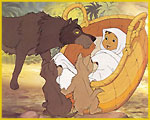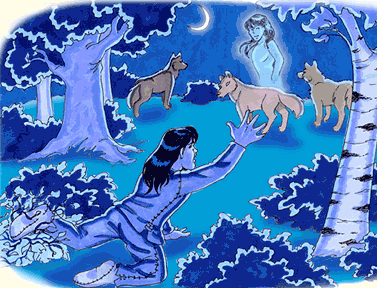|

| |
Werewolf Genetics

You may have seen them in a circus under a variety of names. Most recently the Wolf Boys from Mexico as well as countless bearded ladies and dog-faced people which have become traditional attractions in carnivals: Hirsute people. Men and Women with hair growing from every part of their body. Today, we know this to be a genetic condition known as Congenital generalized hypertrichosis and it affects both women and men all over the world. It is often
hereditary, sometimes leading to entire hirsute families.
One of the most celebrated cases was Adrian Jefficheff - a man from the Caucasus Mountains in Russia. His young son was also afflicted by the condition. Though Adrian amassed a great fortune, it all meant little to him. He believed that his condition had doomed his soul to eternal damnation.
Adrian's son went on to become a huge commercial success himself as "Jojo": The Wolf Boy -perhaps the single most famous wolfman act in carnival history. His manager maintained that Jojo had been raised by wolves in the Russian forests where he'd been captured by trappers.
In public, he only barked and growled, but behind the hairy facade, Jojo fluently spoke four languages and was considered a keenly intelligent individual by those who knew him well.
Stephan Bibrowski - aka Lionel was aptly nicknamed - was almost completely, except for the soles of his feet and palms of his hands, covered with tawny hair. The comparisons to the king of beasts was inevitable.
Though most likely apocryphal, in 1910 the explorer W. Slone reported a tribe of people in New Guinea who had tails. It was reported that these tails were approximately the same size as a dog's and that the natives cut holes in the floors of their dwellings that allowed them their tails to hang when they slept.
Today, it is accepted that there is no one tribe of tailed-people, but the medical condition is not unknown. In the human fetus, the coccyx is extended to contain the spinal cord fluid. As the fetus grows, the coccyx shrinks and is absorbed into the back and buttocks. In some people this does not happen fully resulting in a vestigial tail which is generally malformed and lacking in movement. It is standard surgical procedure to remove these aberrations.
Goddesses of fertility were originally depicted as having multiple breasts. The condition is not unknown to occur amongst mortal folk either - the medical term is Polymastia and it affects both sexes. Women tend to have more teats than men afflicted by this condition.
 Wolf Children Wolf Children
Rudyard Kippling wrote about a young Indian boy adopted by a family of wolves. Seeing that he lacked fur, they named him "Mowgli" or "Little Frog". He did however grow up to become a hunter and in time killed Shere-Khan, the tiger - the biggest threat to his pack.
Stories oftentimes have at least some of their basis on reality. In the early 20th century, there came a stream of reports of wolf children from India and baboon children, gazelle children and monkey children from Africa. These were classified as Homo ferus by Swedish taxonomist Carolus Linnaeus in the 18th century and were collectively given the name "Wolf Children" because of their wild-behavior, disdain of authority, dislike of clothes and in many cases, an affinity for raw meat.
These children often howled, barred their teeth to indicate displeasure, panted when hot and ran around on all fours.
Such is the case of Amala and Kamala - two feral girls found in the vicinity of Calcutta, India. A local missionary flushed out three grown wolves out of a den and there, curled up in the fetal position along with two other wolf-cubs, were the two girls. They were placed in small cages and transported to the local orphanage. The trip took its toll on them and when they finally arrived, they were barely strong enough to sip water from a damp
handkerchief. Amala died a year later at the age of two and a half. Kamala - eight at the time she was found - lived to the age of 17 when she finally died of uremic poisoning. Probably the result of the diet she kept. Current belief is that many of these children were severely autistic. Many - like Amala and Kamala - exhibit the same signs as these so called wolf children: biting, howling, eating raw meat, insensitivity to heat or cold and a keen
affinity to sounds and smells.
Jean Grenier - a self declared werewolf - exhibited all of the pathological behavior ascribed to wolf-children. A court found him guilty of being a werewolf and sentenced to death; subsequently given leniency and instead condemned to spend the rest of his days in a Franciscan Friary.
A much more benign fate awaited a landmark case for the treatment of wolf children: Victor of Aveyron from France was accurately diagnosed as autistic by Jean Itard who patiently and lovingly worked with the boy for years. Victor never learned to speak and retained many behavioral quirks but he did live to the relatively ripe old age of 40.
Human Wolves
An eight-century text Liber Monstrorum - The Book of Monsters - describes a strange race of people living off the edges of the civilized world which feasted on human flesh. This text most likely quotes Plini - who earlier on describes a race known as the Cynocephali or 'Dog-Headed' people.
The folk of the time believed that animals and people were composed of vital essences. To some degree, these were compatible with each other and this placed a heavy burden and
responsibility on the individual to prevent monsters such as the Cynocephali on a moral and religious basis. During the middle ages, myths about monsters brought about by the
unnatural union of man and beast were very popular. One can only speculate that these might be artifice of overactive imaginations to feed our curiosity for the exotic and a fascination with the grotesque - similar to our modern love
affair with horror movies and haunted houses.
From classical mythology, Middle Ages people inherited a host of human-animals who were part a strange amalgams of the human, the animal and the divine. These beings were the antithesis of humans - often covered with hair, keeping a feral diet mostly consisting of raw foodstuff, lacking speech and using only primitive tools. These people were commonly
referred to as "Wild Folk" and people had trouble classifying them as either human or animal.
One such example was Grendel in Beowulf who is described as descended from Cain (and therefore human) but having animal-like qualities - such as extraordinary strength, a penchant for human flesh and antipathy towards humans (whom he considered prey). It's easy to see how these "Wild Men" could in turn give rise to the werewolf myth.
Bestial qualities were not only birthright. They could also be induced. In 1880 a Dr. MacGowan - allegedly a reliable and objective reporter - claims to have witnessed operations in China whereby the hides of dogs and bears were grafted onto the bodies of children. The process was gradual and excruciatingly painful - usually driving the victim mad - which was just as well because it made the subjects appear fiercer and wilder. It is said that vocal chords were severed so that the child was only capable of voicing the
guttural barks and growls of the creature he/she was intended to resemble. Joints were broken to force the would-be animal to walk on all fours.
 Psychotropic Werewolves Psychotropic Werewolves
Deadly nightshade, mandrake root, fat from an un-baptized child... all ingredients in potions thought to effect transformations from human to beast. By the light of the moon, witches would gather the ingredients necessary for transformation potions: Berries of yew - so poisonous that nothing would grow in its shade, purple cowl-shaped monkshood,
corpse-gray hempbane blossoms, thorn-apple and tiny wreaths of hemlock. In its many variants,
recipes for powerful and vivid hallucinations.
In the middle ages, it was thought that effecting the change from man to wolf could be
achieved through the use of magical salves and potions - most of them crafted by the devil himself - and given to his servants to cause havoc and grief amongst the good folk of the time. It is more likely that people who used these salves were under the illusion of having transformed into animals and free to roam through the woods in the guise of wolves - freed from their inhibitions and endowed with the cunning, and strength attributed to the beasts they believed themselves to be.
It is likely that most werewolves were willing participants of transformation, there is one theory which might account for unwilling werewolves: A fungus which grows on wheat - "Ergot" Claviceps purpurea is theorized to be responsible for many schizophrenic werewolves in Europe. The active chemical in Ergot can be synthesized into Lysergic Acid Diethylamide or L.S.D. However, there's some question as to how likely that is to happen given the massive amounts of ergot that would be needed to cause hallucinations and the fact that even if significant quantities of the alkaloid existed on the grain, they would most likely be destroyed in the baking of the dough into bread. Supporters of this theory would argue that the effects of ergot are
cumulative and would result in eventual systemic poisoning, schizophrenia and delusions of
lycanthrope.
 Case Histories Case Histories
Accusing one of being a werewolf in the middle ages became a very convenient way of disposing of the unwanted and undesirable. In 1570 a wolf had killed several children in the area of Lyon, France. A local hermit who lived in a cave - Gilles Granier - was found scavenging a dead body. He was accused of being a werewolf and through intimidation forced to confess to it. He was burned alive on 1573.
In 1598, Paris - Michel Verdun and Pierre Burgot were accused of having sexual relations with wolves and executed.
A case of self-confession is that of Jean Grenier - a fourteen year-old. He accused his father and a friend of his father of being werewolves. He provided full and gory details of the carnage they brought about on helpless victims and was condemned to death in 1603. Because of his age, he was
transferred instead on a plea of clemency to a Franciscan friary in Bordeaux where he spent the remainder of his days pathologically attached to werewolf lore - demanding to eat nothing but raw meat, howling like a wolf by night and running on all-fours on horribly deformed hands.
Then, there's entire families of werewolves - like the Gandillion family in the sixteenth century. The sister - Pernette - is said to have attacked two children and killed one of them. In turn, she was killed by an angry mob. Her two brothers: Pierre and Georges were accused of being witches themselves and were incarcerated. They claimed to be able to transform themselves into wolves through the use of a magic salve. Pierre, George and another sister named Antoinette were subsequently executed.
 Spiritual Werewolves Spiritual Werewolves
Even by the 15th century, people were skeptical that werewolves had the physical ability to
transform into beasts. The theory put forth was that people didn't actually change into beasts, but rather fell into a catatonic state in which the soul left the physical body and took
possession of the actual animal to do that person's bidding. The wolf - being the "Devil's Dog" was the natural agent of choice.
The Malleus Maleficarum published in 1487 has a very comprehensive chapter which pertains to werewolves. It uses biblical quotes from Leviticus "If you don't keep my commandments I will send the beast of the field against you" and Deuteronomy "I will send the teeth of the beast down on them" to make a point that it was an actual wolf which did the deed - albeit under a witch's control. It also suggests that witches can change wolves into men, but that this is actually only a perceptual change - an illusion - because only God can actually effect a change.
Wolves were generally seen as agents of mayhem - when possessed by the devil or in rare occasions by God as a means of divine retribution - as we can see from the quotes above.
Though there was disagreement as to whether or not people could physically turn into wolves or not, most agreed that werewolves were real - as were their victims. God allowed the Devil to do his work to test people, to give human suffering meaning. Overwhelmingly, the creature of choice for the task of divine punishment or testing devotion has always been the wolf.
In the east, Buddhism began in India and then spread into China and Japan. Buddhism states that the ultimate state of Nirvana can only be attained by breaking the cycle of re-birth by following a moral code based on 8 principles. As a soul becomes more enlightened it moves from more 'basal' forms to more advanced or 'divine' forms. Before becoming human, one must be an animal. It is conceivable that - if this concept is true - then one could speculate that vestigial memories from previous existences could somehow travel from body to body.
This is not an exclusively eastern philosophy however. Again if we look at early European history, the souls of heinous criminals were condemned to inhabit the bodies of animals to atone for their crimes. These were generally rats or wolves. Before being sent back to earth, these souls were given a brew called "Broth of Oblivion" which removed all ability to talk or communicate in any human language, while preserving the identity of who they were in previous lives and their cognition to allow them to despair over their current state of being.
...And Today?
Well, if you thought werewolves were creatures of the middle ages, think again. There's a healthy population of werewolves that I was able to meet over the web. The thoughts of what characterizes a werewolf are
manifold and equally varied. The reader will find that it encompasses many aspects and disciplines ranging from theological and spiritual down to people who try to understand the physics of shape-shifting. I have come to learn that shifting into a werewolf is the means to an end, and that end is ultimately to be happy. A common goal for wolves and men alike. I believe that bliss the goal we seek and to quote a
Taoist proverb "Miss the moon because we're so intent in looking at the finger which points to it". I believe that there MUST be truth to werewolves. Fundamentally, I feel it to be right, I feel it to be true, because it stems from personal conviction. Because I feel it inside me. Because I am not like most people and I know this. And what I know inside me feels canine - and right. Accept it or pass
judgment on it, it will not change my perspective.
I originally found others that felt this way in a newsgroup called Alt.horror.werewolves or AHWW for short. Recently, like most other newsgroups, it's full of spam and it's hard to keep up with all the messages there. It was a nice introduction, I met some very nice people there, but the signal to noise ratio is no longer there and so, the reader is warned that there might be spamming ahead.
|
